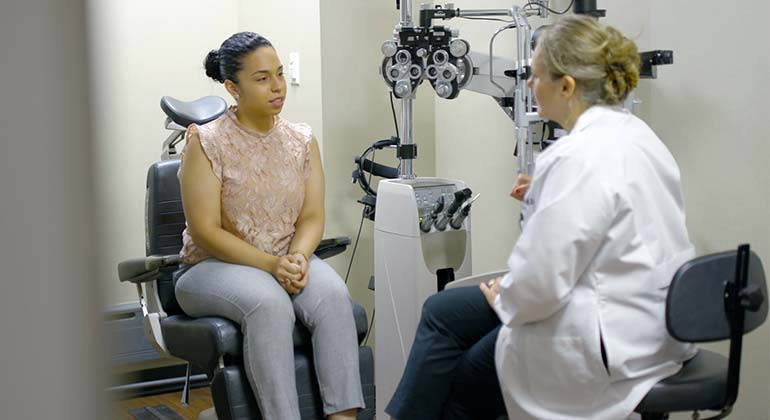Andalusia Pediatrics: Compassionate Take Care Of Your Children
Andalusia Pediatrics: Compassionate Take Care Of Your Children
Blog Article
The Advantages And Disadvantages of Various Refractive Surgeries for Improved Eyecare

LASIK Surgery
LASIK surgical procedure is a commonly performed refractive procedure that aims to remedy vision problems such as nearsightedness, farsightedness, and astigmatism. During the procedure, a thin flap is developed on the cornea, and a laser is used to improve the underlying tissue, correcting the refractive error.
Among the main benefits of LASIK surgery is the quick improvement in vision experienced by numerous people. Most individuals observe a considerable improvement in their sight quickly after the procedure, with very little downtime required for healing. Additionally, LASIK is recognized for its high success rate and reduced incidence of issues when done by skilled surgeons. Like any surgical procedure, LASIK also lugs some dangers, including dry eyes, glow, halos, and under or overcorrection of vision. It is essential for individuals considering LASIK surgical procedure to go through a comprehensive assessment by an eye treatment specialist to determine if they appropriate prospects for the treatment.
PRK Procedure
The PRK procedure, also understood as Photorefractive Keratectomy, is a type of refractive surgical treatment that aims to deal with vision problems comparable to LASIK surgical treatment. Unlike LASIK, which includes developing a flap in the cornea, PRK works on the surface layer of the cornea. During the PRK procedure, the external layer of the cornea, called the epithelium, is removed to allow improving of the underlying corneal tissue with an excimer laser. This improving helps to deal with refractive errors such as nearsightedness, astigmatism, and farsightedness.
One of the benefits of PRK over LASIK is that it gets rid of the danger of flap-related complications because no flap is created during the surgical treatment. This can be beneficial for individuals with slim corneas or those entailed in get in touch with sporting activities where eye injury is an opportunity. The recuperation time for PRK is commonly much longer contrasted to LASIK, as the outer layer of the cornea requires time to restore after the procedure. Regardless of the longer recovery period, PRK can be an ideal choice for individuals seeking vision improvement surgical procedure.
SMILE Surgical Procedure
A sophisticated refractive surgery technique getting popularity in the area of ophthalmology is SMILE Surgery. Tiny Cut Lenticule Removal (SMILE) is a minimally intrusive procedure that deals with vision by improving the cornea making use of a femtosecond laser. Unlike conventional LASIK surgical procedure, SMILE Surgery includes producing a tiny cut in the cornea to remove a lenticule, which leads to less disturbance to the corneal structure and potentially faster healing times.
One of the main benefits of SMILE Surgical treatment is its capability to treat nearsightedness (nearsightedness) and astigmatism with high precision, leading to excellent aesthetic end results for individuals. The minimally intrusive nature of the procedure likewise lowers the threat of problems such as dry eye syndrome, making it a desirable alternative for people seeking refractive surgical treatment.

LASEK Strategy
Having checked out the benefits and considerations of SMILE Surgery, an additional notable refractive surgery technique worth taking a look at is the LASEK Strategy. LASEK, which stands for Laser-Assisted Subepithelial Keratectomy, is a form of laser eye surgery that intends to remedy refractive mistakes such as myopia (nearsightedness), hyperopia (farsightedness), and astigmatism.
Unlike LASIK, LASEK does not include creating a corneal flap. Rather, during a LASEK procedure, the specialist uses a diluted alcohol option to loosen the thin outer layer of the cornea, known as the epithelium.
Among the key benefits of LASEK is that it can be suitable for individuals with thin corneas who might not be excellent prospects for LASIK. Additionally, LASEK typically results in very little post-operative pain and a quicker recuperation time compared to PRK. Nonetheless, the visual healing procedure with LASEK might be a little longer than with LASIK.
Implantable Call Lenses
Implantable Get in touch with Lenses provide a lasting vision correction click to read more solution for people seeking an option these details to traditional contact lenses or glasses. These lenses, likewise understood as phakic intraocular lenses, are surgically put into the eye to correct refractive errors such as myopia (nearsightedness), hyperopia (farsightedness), and astigmatism. neurologist Andalusia. Unlike conventional call lenses that rest on the surface area of the eye, implantable contact lenses work within the eye itself, offering clear vision without the need for everyday upkeep or elimination
One of the essential advantages of implantable get in touch with lenses is their durability. When put, they can remain in the eye forever, offering regular and secure vision correction. Additionally, these lenses can be a superb alternative for people that are not good candidates for laser eye surgery or who choose a relatively easy to fix vision improvement treatment.
However, implantable contact lenses do carry some dangers, including the possibility for cataracts or increased eye stress. It is essential for individuals considering this alternative to seek advice from with an eye treatment professional to determine if implantable contact lenses are the best selection for their specific demands and eye health.
Conclusion
Finally, each sort of refractive surgical treatment has its own benefits and negative aspects. LASIK surgical procedure is popular for its quick recovery time, while PRK procedure may be ideal for people with thin corneas. SMILE surgery offers minimal discomfort throughout the procedure, however LASEK technique may have a longer healing procedure. Implantable call lenses give an option for those who are not ideal prospects for conventional surgical treatments. Clients must talk to their eye treatment company to determine the ideal choice for their private needs. Recommended Reading

Overall, SMILE Surgical procedure offers an appealing option for individuals looking to improve their vision via refractive surgery.
Report this page